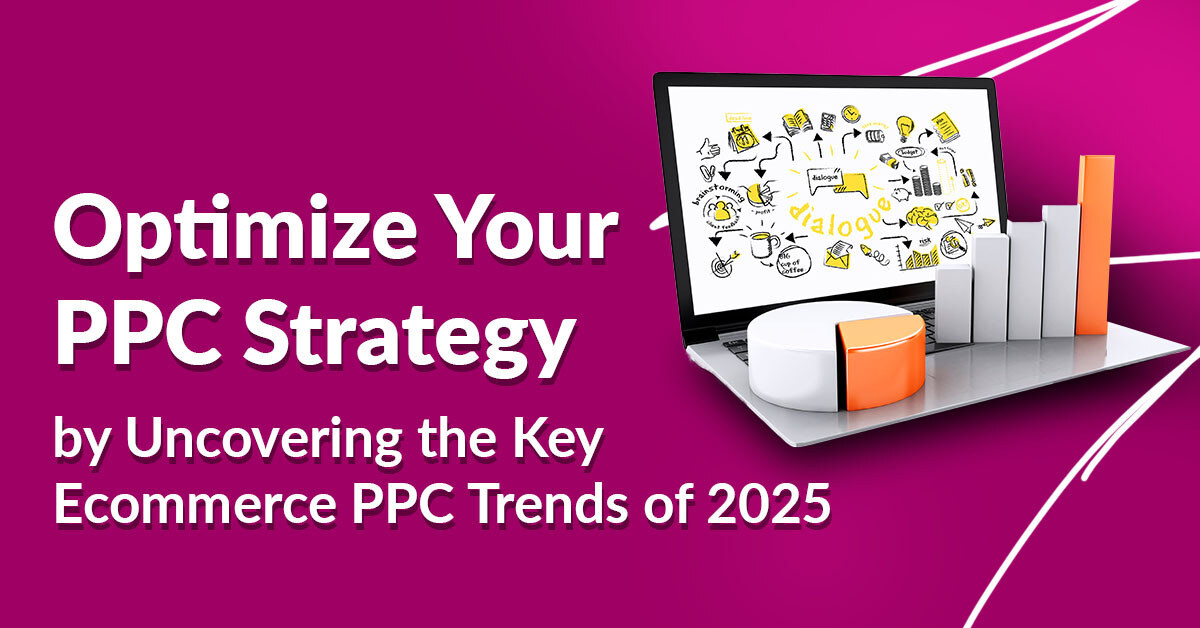PPC advertising continues to be a powerful tool for ecommerce businesses, helping them attract the right audience, increase conversions, and track their success with clear, measurable outcomes. PPC ads can significantly elevate a business's brand visibility, with an average increase of 80%.
PPC has a profound impact on ecommerce growth. It allows brands to connect directly with potential customers through precise targeting, whether they’re searching for products on Google, browsing social media, or engaging with video content. With advanced tools and platforms, PPC campaigns can deliver personalized experiences, building trust and encouraging repeat purchases. This level of engagement drives sales, enhances brand visibility, and fuels business expansion.
As consumer behaviors and technologies evolve, staying informed about emerging ecommerce trends ensures that businesses can adapt and maintain a competitive edge. Ignoring these shifts can lead to missed opportunities and reduced ad performance, making it harder to achieve ROI goals.
The pay-per-click trends of 2025 will shape ecommerce paid advertising strategies by incorporating advancements like voice search, video content, and omnichannel approaches. With these innovations, businesses will be able to run smarter campaigns, provide more personalized customer experiences, and increase ROI.
Key Ecommerce PPC Marketing Trends for 2025
Understanding and adapting to these ecommerce PPC trends will be essential for maximizing the effectiveness of ecommerce PPC in 2025 and beyond.
The Role of Sustainability in Ecommerce PPC
Sustainability is becoming a key factor in consumer purchasing decisions, and it's increasingly influencing ecommerce PPC strategies. As more shoppers prioritize eco-friendly products and brands that demonstrate environmental responsibility, incorporating sustainability into PPC campaigns is essential for staying relevant.
For ecommerce businesses, promoting sustainable practices or eco-friendly products through PPC ads can create a strong connection with environmentally-conscious consumers. This can include highlighting products made from sustainable materials, ethical manufacturing processes, or the brand’s efforts to reduce its carbon footprint.
Using sustainability-focused messaging in PPC ads enables brands to differentiate themselves, attracting consumers who prioritize ethical and eco-friendly products, and are often willing to pay extra for items that align with their beliefs.
Additionally, as paid search advertising trends shift to include eco-friendly and green terms, ecommerce businesses can adjust their PPC keywords to target these growing interests, enhancing visibility and driving more relevant traffic.
Privacy and Data Protection: Adapting to New Regulations
As privacy concerns grow, ecommerce businesses must adapt their PPC strategies to comply with stricter data protection regulations. With regulations like the GDPR in Europe and CCPA in California, businesses are facing increasingly strict guidelines on how they gather, manage, and protect consumer data, ensuring greater privacy and transparency.
For ecommerce brands, this means being transparent about how data is collected and giving consumers more control over their information. PPC campaigns that rely heavily on personal data for targeting may need to shift toward more privacy-conscious practices. For example, businesses may have to avoid using sensitive information without proper consent and focus more on aggregated data rather than individual tracking.
As these regulations take effect, businesses will need to shift toward contextual targeting — delivering ads based on the content users engage with — rather than depending solely on personal data. Additionally, focusing on first-party data (information collected directly from users, like email lists or website interactions) will be crucial as it ensures better compliance and more trustworthy customer relationships.
Ultimately, staying updated with privacy regulations and adjusting ecommerce PPC strategies accordingly not only helps businesses avoid legal risks but also builds trust with consumers who are increasingly concerned about their online privacy.
Increased Focus on Video and Visual Content

Visuals and videos are increasingly driving digital marketing strategies, with their influence expected to continue growing in the years to come. For ecommerce businesses, using video and eye-catching visuals in PPC ads is becoming more important than ever. Consumers are more likely to engage with content that is dynamic and captivating, making videos, images, and interactive visuals highly effective in grabbing attention and boosting conversions.
Video ads offer a unique way to showcase products in action, demonstrate how they work, and highlight their benefits. Platforms like YouTube, Instagram, and TikTok make it easier for brands to use short-form video ads that quickly grab attention and encourage users to take action. Shoppable videos, where users can directly purchase items featured in the video, are also growing in popularity.
82% of people claim that watching a brand’s video influenced their decision to buy a product or service.
Visual content, like high-quality images and infographics, plays a crucial role in ecommerce PPC campaigns by providing a clear, appealing way to display products. With ecommerce shoppers often scrolling through many options, stunning visuals can make a big difference in standing out from the competition.
Voice Search and Conversational Commerce
As voice assistants like Amazon Alexa, Google Assistant, and Apple Siri grow more embedded in daily routines, voice search is emerging as a key tool for product discovery and online shopping.
Voice search allows users to find products by simply speaking commands, making it faster and more convenient than typing queries. This shift means ecommerce businesses need to adapt their PPC strategies to include voice-friendly keywords and phrases that people naturally speak. Voice searches tend to be more conversational and longer, so brands should focus on targeting these types of queries in their campaigns.
Conversational commerce involves using messaging platforms, chatbots, and voice features to facilitate interactive shopping. These tools allow consumers to ask questions, receive personalized product suggestions, and even complete purchases — all through live, conversational interactions. For ecommerce businesses, integrating chatbots or voice assistants into PPC ads can enhance the customer experience by providing immediate, personalized responses to inquiries.
Hyper-Targeting and Personalization at Scale

As consumers expect more relevant, tailored experiences, businesses are using advanced technologies to create highly personalized ads that resonate with individual preferences and behaviors.
Hyper-targeting allows businesses to focus on highly specific audience segments, considering elements such as previous purchases, online behavior, location, demographics, and even the time at which users engage. This allows businesses to deliver more precise and effective ads to the people most likely to convert. For example, instead of showing a generic ad to everyone, a brand can target users who have previously viewed a particular product or added it to their cart but didn’t complete the purchase.
Personalization at scale takes this a step further by using data and automation to create individualized ad experiences for a large number of customers. By utilizing AI and machine learning, businesses can efficiently process extensive customer data and seamlessly refine their PPC campaigns, delivering personalized product recommendations, tailored messaging, and exclusive offers to each individual. This guarantees that ads reach the right audience with content that aligns with their specific preferences and needs.
Personalized ads often see a click-through rate of about 2.30%, significantly surpassing the performance of ads that aren't tailored to individual preferences. Highly targeted personalized ads tend to result in an even greater CTR.
Strategies to Leverage These Ecommerce PPC Trends of 2025 Effectively
Here are some strategies you need to implement to leverage these ecommerce PPC trends 2025 in an effective manner.
Incorporating Sustainability Initiatives
Aligning PPC Campaigns with Eco-Conscious Messaging and Actions
More consumers are considering the environmental impact of their purchases, and this growing focus on sustainability is shaping their buying habits. By incorporating eco-friendly messages into your PPC campaigns, you can attract environmentally-conscious shoppers, enhance brand credibility, and set yourself apart in a competitive market.
- Highlight Sustainable Products: Use your PPC ads to spotlight eco-friendly products, materials, and ethical manufacturing processes. Whether it’s organic cotton clothing, reusable packaging, or carbon-neutral shipping, ensure your ads clearly communicate these sustainability features. Make it easy for consumers to understand the environmental benefits of the products they’re purchasing.
- Eco-Friendly Messaging: Beyond products, consider integrating sustainability messaging into your ad copy. Share how your brand is contributing to environmental causes — whether it’s through a commitment to reducing carbon emissions, sourcing ethically, or supporting environmental nonprofits. Transparency about your eco-friendly practices can help establish a positive brand image and foster customer loyalty.
- Targeting Eco-Conscious Audiences: Use targeting ecommerce marketing strategies to reach consumers who have shown an interest in sustainability. Look for keywords like "eco-friendly," "sustainable," or "green products" in your PPC campaigns. You can also refine your audience based on behaviors such as searching for environmental causes, engaging with eco-friendly brands, or discussing sustainability on social media.
- Incorporate Eco-Friendly Landing Pages: Ensure that the experience for eco-conscious consumers is seamless. Create dedicated landing pages that showcase your sustainability initiatives and sustainable product offerings. These pages should include information about the environmental benefits of the products, certifications like Fair Trade or Carbon Neutral, and any efforts your brand is making to reduce its environmental impact.
Adapting to Privacy Changes

Building Robust First-Party Data Strategies
As privacy concerns grow and regulations like GDPR and CCPA become more prominent, businesses need to reassess their methods for collecting, storing, and utilizing consumer data in their PPC campaigns. By 2025, stricter regulations will likely be in place, so building a strong first-party data strategy is essential for staying compliant while still running effective PPC ads.
- Focus on First-Party Data: First-party data refers to the information that you collect directly from your customers, such as email sign-ups, website interactions, and purchase history. This data is invaluable because it is collected with consent, ensuring compliance with privacy laws. By leveraging first-party data, you can create highly targeted PPC campaigns that speak directly to your audience’s needs, without violating privacy regulations.
- Encourage Data Sharing: One of the most effective ways to gather first-party data is by incentivizing users to share information. Provide special deals, limited-time offers, or valuable content such as ebooks or webinars as incentives for customers to sign up with their email or take part in surveys. This helps build a robust database of interested customers while respecting their privacy preferences.
- Prioritize Transparency and Consent: Be clear with your audience about what data you are collecting and how it will be used. Being transparent with simple privacy policies and giving customers control over their data collection preferences is key to fostering trust. This transparency will be essential in adapting to evolving privacy laws and keeping your brand in good standing with consumers.
- Leverage Privacy-Focused Ecommerce Paid Advertising Platforms: Platforms like Google Ads and Facebook are adapting to privacy changes by offering new tools that allow advertisers to run campaigns without relying heavily on third-party data. Use these tools to target users based on their behavior on your website or app while complying with privacy standards.
Using Video Ads Effectively

Best Practices for Video Ad Creation and Placement
Video content continues to rise in popularity and effectiveness, and its role in ecommerce PPC is only expected to grow in 2025. Video ads can provide a dynamic way to showcase products, tell a brand story, and drive engagement. Here’s how to make the most of video ads:
- Keep it Short and Engaging: Attention spans are shorter than ever, so it’s crucial to capture your audience’s attention quickly. Create short, impactful videos (15-30 seconds) that capture attention quickly. Highlight the key benefits, standout features, or emotional connection your product offers right from the start. Videos that convey a clear, concise message are more likely to drive conversions.
- Incorporate a Strong Call-to-Action: Make sure your video ads have a clear and direct call-to-action (CTA). Whether it’s “Shop Now,” “Learn More,” or “Get 20% Off Today,” a strong CTA encourages viewers to take the next step in their purchase journey. Place the CTA strategically at the beginning and end of the video to ensure it doesn’t get missed.
- Use Platforms that Prioritize Video: Social media platforms like YouTube, Instagram, and TikTok are key places for video ads, as they prioritize video content in their algorithms. Make sure your video ads are optimized for each platform, taking into account their specific format and audience preferences. For example, on Instagram, use vertical video to make the most of mobile screens.
- Targeting the Right Audience: Just like with traditional PPC ads, you’ll want to ensure that your video ads are being shown to the right audience. Tap into demographic, interest, and behavioral insights to identify and reach the customers most inclined to interact with your video content. Platforms like YouTube and Facebook offer advanced targeting features to help your video ads connect with the most relevant viewers.
- A/B Test Your Video Content: Don’t be afraid to experiment with different video formats, messaging, and CTAs. A/B testing allows you to compare performance and figure out what resonates best with your audience. Testing various elements of your video ads, such as visuals, scripts, and CTA placement, helps refine your strategy over time.
Optimizing for Voice Search
Using Natural Language and Long-Tail Keywords in PPC Campaigns
People tend to use natural language when speaking, and voice searches often involve longer, more conversational phrases. This shift means ecommerce brands need to adjust their PPC strategies to optimize for voice search.

- Focus on Long-Tail Keywords: Voice searches tend to be more detailed and conversational than typed queries. For example, a person might ask, "What are the best eco-friendly shoes for women?" rather than simply searching for “eco-friendly shoes.” By incorporating long-tail keywords and natural language phrases into your PPC campaigns, you can better align with how people use voice search.
- Answer Questions in Your Ads: Voice searches are often question-based, so structuring your PPC ads to answer these queries can help you rank higher for relevant searches. If a user asks, “What are the benefits of organic skincare products?” you could create an ad that directly addresses the benefits of your products, making it more likely that your ad will appear in response to that query.
- Optimize for Local Search: Many voice searches are location-specific, such as “Where can I buy shoes near me?” Ensure that your PPC campaigns include local keywords and are optimized for local search intent. This will help capture potential customers who are searching for nearby stores or services.
- Use Structured Data: Structured data, such as schema markup, helps search engines understand the content of your website and improves how your site appears in voice search results. Implementing schema can help your site rank better for voice search queries by providing more context to search engines about your business, products, and services.
Predictions and the Future of Ecommerce PPC
Looking past 2025, the ecommerce PPC landscape is poised for significant transformation, driven by the rise of emerging technologies such as augmented reality and virtual reality. These innovations will transform the way consumers interact with ads, enabling immersive experiences that allow customers to virtually try on products, explore virtual stores, or visualize how items will look in their homes before purchasing. This shift will create new opportunities for brands to engage customers in more personalized and interactive ways.
Additionally, artificial intelligence (AI) will continue to drive automation and optimization in PPC campaigns. As machine learning technology advances, businesses will have the ability to launch highly personalized campaigns that automatically optimize in real-time, enhancing ad performance and ROI with less hands-on management.
The rise of these technologies means that ecommerce brands must stay adaptable. The digital marketing world moves quickly, and the ability to embrace new tools and ecommerce marketing strategies will be essential for staying competitive. Businesses that remain flexible, experiment with innovative ad formats, and continually analyze performance will be best positioned to thrive in an increasingly tech-driven ecommerce environment.
Final Thoughts
As digital marketing evolves, staying ahead of emerging ecommerce trends, testing innovative ad formats, and refining campaigns with data-driven insights will be key to success. With the right approach, 2025 could be your most successful year yet in ecommerce PPC.
If navigating these changes feels overwhelming, you can always reach out to an expert PPC agency to guide you through the process and ensure your campaigns are optimized for success.










